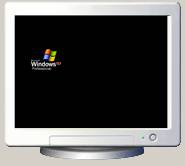|
Operating Systems
An operating system is the ensemble of procedures, manuals, and modules of system programs that administrates the system's resources. The operating system assures the efficiency of resources combined work and provides a user friendly interface. You can appreciate that the operating system is a graphical interface between the hardware components and the user or the applications.
Functions
• Operating systems must let the user load the desired applications. It has to offer:
• a text editor;
• a translator;
• a link editor.
• Allocation table for program execution. This happens by identifying the programs to be executed, the needed amount of memory, the preferred devices, and the concerning requests.
• Facilities for data compression, organizing and stocking libraries etc.
• Scheduling execution for different works;
• Program execution assistance - intermediation the system-user communication.
The intermediating role of the operating systems is organized on 2 levels:
• the physical level - which is more connected to the system hardware and uses interruptions;
• the logical level - that is closer to the user, communicates with it by a series of commands, programming language, etc.
According to these two levels, the operating systems manage two types of programs:
• control and command programs, with a coordinating role and control all the operating system's functions, like IO processes, execution's interruptions, hardware-user communication;
• service programs - executed under the supervising of the control and command programs; they are used by the programmers to develop applications.

Development
First operating system was functioning in a mono programming regime.
In this case, the CPU executes only one instruction in a specified time and it can not operate unless the data is loaded in the internal memory. If the peripheral devices are slow when working with the internal memory, CPU must wait for the transfer to be finished to start executing other programs.
If you have a simple operating system, then the programs are executed in a serial mode, which takes it to inefficiency in CPU usage.
Operating system types
Usually, there are two types of operating systems:
• monotasking - executes just one program at a time, realizing two basic functions:
• load and execution of the programs;
• assurance of an interference whit the peripheral devices.
• Multitasking - the operating system's kernel must assure a time partitioning between the programs to be executed, the principal components are :
• The supervisor - launches, stops and suspends the allocation;
• The planner - sets the execution time of operation to be made;
• The section for resource allocation - identifies the free resource or the allocated ones
• The management module for IN/OUT, which assures the pheriferal communication.
Types of operating systems
• MS-DOS (MicroSoft-Disk Operating System)
• The DOS microcomputers development started in 1978, when INTEL CORPORATION released the I 8088 processor, then the I 8086 processor, that could use more internal memory.
• OS/2 (Operating System/2)
• In 1988, IBM and Microsoft released OS/2.
• Apple DOS
• Is a mono user operating system, monotasking; a more performing operating system is MacIntosh.
• UNIX
• Was created for minicomputers, to higher the system capacities: virtual memory and multitasking.
• Windows 3.1
• This is a windows oriented graphic interface, installed on a MS-DOS based system. The user can load many applications and use them, every one in its own window.
• Windows NT (NT - New Technology)
• This is a very complex operating system, released by Microsoft and has the advantage to work on Intel and RISC.
• Windows 95
• It is an operating system that embeds a series of new facilities as a plus for the previous editions.
• Windows 98
• This operating system is a medium integrated with the Internet. It is a support for the new technologies and an update to Windows 95.
• Windows 2000
• Windows Xp
• This operating system is widely used these days, and it became more stable than the previous versions.
 Back To Tips HomePage Back To Tips HomePage
Popular Articles:
How To Build A PC | Different Types of Keyboards | Help with Hard Drive Installation | Computer Networking Basics | Introduction of Motherboard Functions | Computer CPU Processor Speed | Upgrade from Windows 95 to Windows 98 | Computer Monitor Troubleshoot | Partition Hard Drive | Installing New CPU Processor | Types of Network Cables |